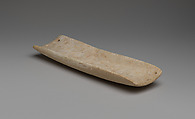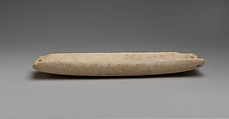On loan to The Met The Met accepts temporary loans of art both for short-term exhibitions and for long-term display in its galleries.
Marble palette
Technical analysis: Ultraviolet-induced visible luminescence examination, optical microscopy
The palette is nearly intact, with chips to the narrow ends as well as a minor loss at one short end and a possible repair at one corner [check]. It is carved from a fine white marble. There are numerous scratches and pits over the top surface and patches of pale brown accretion. Much of the underside is covered with the same buff color accretion.
The palette curves up along the long sides creating a trough shape and it has three drilled holes on each of the short ends. Each of the drill holes was bored from the top and the bottom producing an hour-glass shape. A similar trough-shaped palette in the Dresden Museum is said to have been found in a grave on Naxos with a Louros type figure. It has been suggested that the holes were used to affix a figure, possibly of wood, in place.(1)
Seán Hemingway
(1) See P. Getz-Gentle, "Addenda to the Cycladic Exhibition in Karlsruhe," Archaeologischer Anzieger (1978) p. 9, fig. 14. For further discussion of the type, see P. Getz-Preziosi, Early Cycladic Art in North American Collections (Virginia Museum of Fine Arts, Richmond 1987), p. 294.
This image cannot be enlarged, viewed at full screen, or downloaded.
This artwork is meant to be viewed from right to left. Scroll left to view more.




